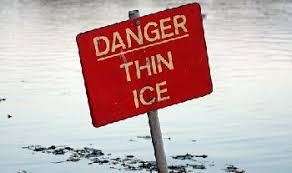
INDIANA – Thousands of Hoosiers safely enjoy fishing, skating, hiking, or just sliding around on frozen ponds and lakes every winter. And every year, people drown after falling through ice.
Don’t let this happen to you or anyone around you.

Indiana Conservation Officers remind Hoosiers to be careful when participating in ice fishing, ice skating, or snowmobiling activities. Remember to put safety first. Take caution when going on frozen lakes, ponds, rivers, streams, and retention ponds. And watch for others who may venture out on frozen waterways and find themselves in trouble.
Similar to driving differently on snowy versus clear roads, safely having fun on ice may require you to adjust from what you have done in the past. The rule of thumb is to believe all ice is thin unless proven otherwise.

Here are a few tips to remember when considering standing on or walking on a frozen body of water:
- Assume no ice is safe ice.
- Test the thickness of the ice with an ice auger. At least 4 inches is recommended for ice fishing; 5 inches is recommended for snowmobiling.
- If you don’t know the thickness of the ice, don’t go on it.
- Wear a life jacket or flotation coat.
- Carry ice picks and rope gear.
- Before going on the ice, note your whereabouts with a friend or family member.
- Don’t test the thickness of the ice while alone.
Wearing a life jacket is especially important when on ice. If you fall through, a life jacket will keep your head above the water until help arrives.
Remember that a new coating of snow, perhaps beautiful, can make for treacherous ice conditions. Snow can serve as insulation, causing water to freeze more slowly. When snow and rain freeze into ice, it is less strong than solid, clear ice.

Another potentially dangerous situation is seeing a pet or other animal in distress on the ice. If that happens, do not go after it. Instead, contact local emergency response personnel equipped to make a rescue.
Here are a few more tips:
- Some bodies of water can appear frozen solid but still have thin ice in several unexpected areas.
- Avoid flowing water, such as rivers and streams, when covered with ice.
- Similarly, water surrounded by sand may freeze with inconsistencies in the thickness of the ice.
- Underground springs, wind, waterfowl, and other animals can also keep areas of ice thin.
Enjoy the winter weather, but make safety a priority.









.png)











